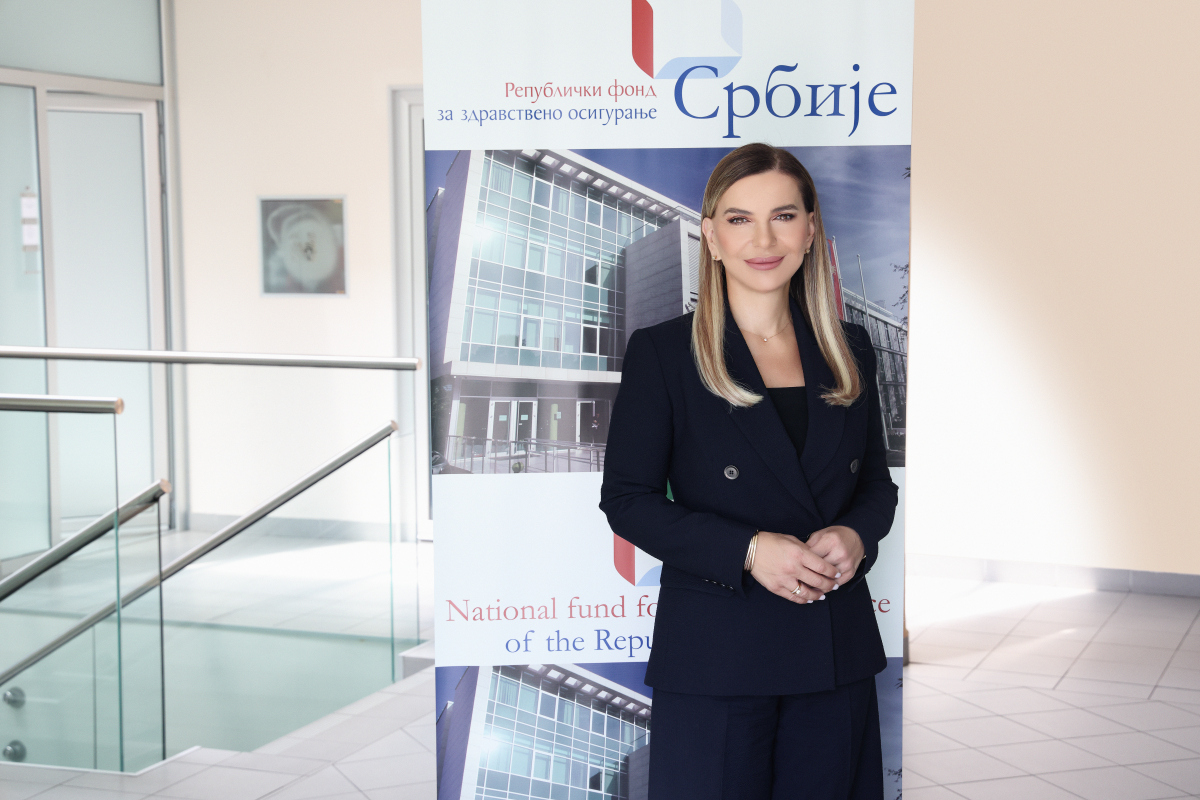Driving Progress in Serbian Healthcare with Cutting-Edge Solutions and International Cooperation
Sanja Radojević Škodrić, Director of the National Health Insurance Fund (RFZO), discusses the challenges and achievements of leading Serbia’s healthcare system, including innovations in treatments, investment in young medical professionals, and the importance of international collaborations.

You have been leading the National Health Insurance Fund (RFZO) since 2017. What have been the biggest challenges you’ve faced as the director of RFZO, and as a woman in medicine?
Being at the helm of the National Health Insurance Fund is in itself a demanding and challenging role, one that carries great trust but also a significant responsibility. Much was different seven years ago compared to today; things have improved in our healthcare system, with the largest investments in history across all segments of medicine, from innovative drugs to innovative methods. Without a doubt, the greatest challenge was the COVID-19 pandemic, and I believe everyone who was part of the healthcare system during that time, which bore the brunt of the pandemic, would agree with this assessment. It was the same in every country, but unlike many others who lacked protective equipment, masks, vaccines, and respirators, we had all of this, thanks in large part to the efforts of Serbia’s President, Aleksandar Vučić. We’ve almost forgotten how it all looked, how exhausting it was, but now, with the benefit of some time, I can say I am incredibly proud of how the entire healthcare system responded and was organised during that situation.
Since 2017, 96 innovative drugs have been added to the list of medicines covered by RFZO
As for women in medicine, I believe the challenges are similar to those faced by women in other professions. Primarily, it involves balancing private and professional life, which requires great support and understanding from family, and a lot of personal sacrifice. In medicine, men still dominate leadership positions, but this is changing, and now we have women in several important roles, including, as of recently, at the head of the Clinical Centre of Serbia. As the director of RFZO, I am pleased to highlight that the majority of employees at the Fund are women, and they are capable and skilled professionals dedicated to their work. The most important thing, of course, is whether someone performs their role well, not whether they are a man or a woman.
What would you highlight as your most important achievements as the director of the National Health Insurance Fund (RFZO)?
In recent years, progress has been made in various areas of healthcare, but I would highlight the most significant achievements of the National Health Insurance Fund as the consistent and stable supply of medicines, increased availability of innovative drugs, advancements in the treatment of rare diseases, the expansion of rights to in vitro fertilisation (IVF), and the introduction of the human papillomavirus (HPV) vaccine.
Apart from the COVID-19 pandemic, significant changes in the world over the past few years have also impacted the pharmaceutical market. Ensuring the supply of medicines was not easy. Many European countries faced long-term shortages of certain drugs. In our case, we did not face such problems; there were brief periods where specific drugs were unavailable, usually due to production, raw material, or transport issues. We managed to maintain regularity by reacting promptly, ensuring that all essential medicines were produced domestically, and diversifying imports from a wide range of manufacturers in different countries to avoid reliance on a single company.
Serbia ranks first in the world for state-funded in vitro fertilisation (IVF) rights
When it comes to innovative drugs, which change the course and outcome of treatment and are therefore extremely expensive, investments in this type of therapy have been steadily increasing in recent years. As a result, new innovative drugs have been added to the list of medicines covered by RFZO. For example, since 2017, 96 innovative drugs have been added to the list, with an allocation of 16.2 billion dinars. Last year, 22 innovative drugs were added to the list, and the year before, 26, while between 2000 and 2012, only 49 innovative drugs were added over 12 years. Of course, it is not enough to just add a drug to the list; funds must be secured to ensure they remain available to patients for as long as needed. In 2023, the total value of innovative drugs amounted to around 30 billion dinars, which is 7 billion more than the previous year and five times more than what was allocated 6-7 years ago.
There has also been tremendous progress in the treatment of rare diseases in recent years, greatly supported by the efforts of President Vučić and his wife Tamara. The budget for rare diseases was established in 2012 at the initiative of President Vučić and has since grown 55 times, from 130 million dinars to 7.2 billion dinars. As a result, the number of people receiving therapy at the state’s expense has risen from eight to more than 720, and the number of rare diseases covered has increased from two to 40 different rare diseases. It is important to note that only a small number of rare diseases have appropriate therapies. Before 2012, no investments were made in the treatment of rare diseases.

I would also like to highlight the expansion of state-funded rights to in vitro fertilisation (IVF), which has given many couples the chance to have the children they long for. Today, Serbia ranks first in the world in terms of state-funded IVF rights, according to experts. What was revolutionary regarding IVF in Serbia, despite some negative comments, was the introduction of procedures with donated reproductive material at the end of 2022, available not only to women with partners but also to women without partners.
Additionally, in June 2022, the HPV vaccine was introduced as the first innovative state-funded preventive medicine. It is particularly important that it was introduced for both genders, for boys and girls aged nine to 19. The effects of this will be seen in the coming years, once vaccination coverage becomes sufficiently high.
You had the opportunity to visit the AICA pharmaceutical factory in Cuba. Can you tell us more about this collaboration and what it represents for healthcare in Serbia?
Together with Minister Jelena Begović, I was on a working visit to Havana. In discussions with the Cuban Minister of Science and representatives of their pharmaceutical companies, we learned about the innovative biological medicines for which Cuba is renowned worldwide. I visited the BioCubaFarma pharmaceutical factory, which focuses on the development and production of vaccines, biological medicines, and other pharmaceutical products that have contributed to the improvement of Cuba’s healthcare system. I also toured a generic medicine factory. Their medicines are in various stages of clinical trials across the globe, and so far, they have developed more than 900 products, mainly in the fields of medicine and biomedicine. These include a hepatitis B vaccine, which they also export, and they are working on products related to diabetes, cancer, and arthritis. We also discussed the possibilities of collaboration between their institutions and ours, and I hope that this will be realised in the future.
In the past, you mentioned that prevention in healthcare is the most expensive, but in the long term, it is the most cost-effective. Could you share which screenings are conducted in healthcare institutions with the aim of early disease detection?
Prevention is a focus of the most developed countries. Investment in prevention is, in fact, the most expensive investment, but our healthcare policy is that health has no price. Early diagnosis, as part of prevention, is crucial for a positive treatment outcome. People in Serbia are slowly starting to realise this, and they are visiting doctors not only when they have a problem but also to check their health when they have no symptoms. We hope this mindset will fully take root, as preventive examinations are one of the main priorities of the new government’s healthcare policy.
The budget for rare diseases has grown 55 times since 2012, improving treatment access for over 720 patients
In Serbia, screenings covered by the RFZO include early detection of depression, colorectal cancer, type 2 diabetes, breast cancer, cervical cancer, and cardiovascular risk. These tests are conducted in primary healthcare facilities, with all positive results referred to secondary and tertiary institutions for further evaluation.
In addition to adult screenings, several tests are performed for rare diseases in newborns, including for phenylketonuria, hypothyroidism, cystic fibrosis, and spinal muscular atrophy (SMA). Screening for cystic fibrosis was introduced in 2021, and for SMA in September last year. Serbia is one of the few countries where this screening is mandatory. The goal is to diagnose as early as possible so treatment can begin before symptoms appear, as in the past, a lot of time was lost in establishing the diagnosis.
Recently, RFZO concluded a framework agreement for the procurement of drugs to treat two rare diseases in children, ‘butterfly children’ and eosinophilic esophagitis. How important is this therapy for those facing these rare diseases?
These drugs are of immense importance due to the nature of the two rare diseases, epidermolysis bullosa and eosinophilic esophagitis. Epidermolysis bullosa, or ‘butterfly children,’ is a condition where children endure constant pain, with an increased risk of infections and other complications. For the second disease, eosinophilic esophagitis, which three children are receiving treatment for, patients cannot eat normally, suffer from frequent vomiting, have difficulty swallowing, and face other oesophageal problems. This not only disrupts the life of the patient but also the entire family, as rare diseases affect the functioning of the whole family.
Collaboration with Cuba opens doors to cutting-edge treatments and pharmaceutical advancements for Serbian healthcare
There was no treatment for ‘butterfly children’ until May of last year when a gene therapy cream was approved in the US. Its goal is to alleviate the patient’s pain, reduce skin wounds, and mitigate the effects of the disease to make daily life easier for the patient. This cream costs around 600,000 euros per patient per year, depending on the patient’s condition and the surface area of the skin being treated. It is only suitable for one type of epidermolysis bullosa, meaning not all patients can use it. Only nine countries worldwide have secured access to this medication, and Serbia is among them, thanks to the significant support and initiative of Serbian President Aleksandar Vučić.
Two girls have already received the therapy, and it has been approved for six more patients selected by medical experts. No country can fund treatment for all patients at once. So far, France, Germany, Norway, and Italy have treated a total of 14 patients.
Are there any programmes or initiatives that involve investment in young medical professionals?
The state places great emphasis on young doctors and is doing everything it can to provide them with opportunities for further training, so that one day they can lead the healthcare system and remain in the country where they were educated. Since 2018, there has been a programme for employing the best graduates from medical faculties and high school medical graduates. So far, 1,640 doctors and 2,000 top nurses and technicians have been employed in public healthcare institutions through this programme.
Do you have any advice for young people who want to pursue a career in healthcare in Serbia?
Helping people, healing them, and being involved in the arrival of a new life into the world is one of the most noble and beautiful vocations. On the other hand, it requires great dedication, learning, and effort, which not everyone is equally ready for. Don’t forget that medical studies last longer than other degree programmes, and the job requires ongoing professional development. You are in service to your patients even on weekends and holidays. Those who want to be doctors should first have a deep love for this profession and should never forget why they chose medicine and how human and meaningful the work is. As the director of RFZO, I am always proud to highlight that our health insurance is one of the few in the world based on solidarity and humanity.
This interview was originally published in the October edition of Diplomacy&Commerce magazine, issue #99.
Interview conducted by: Mijat Kontić
Photos by: RFZO
